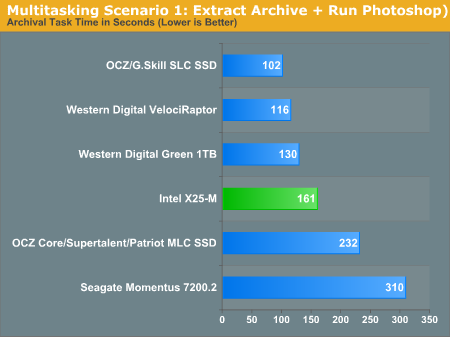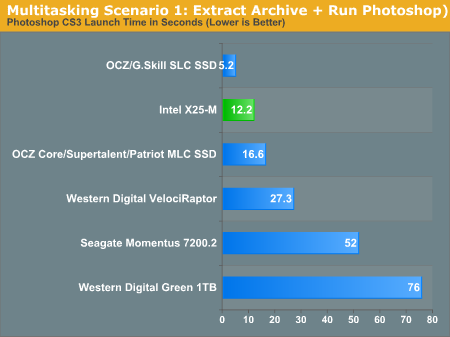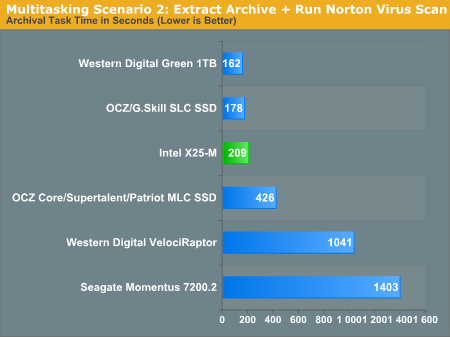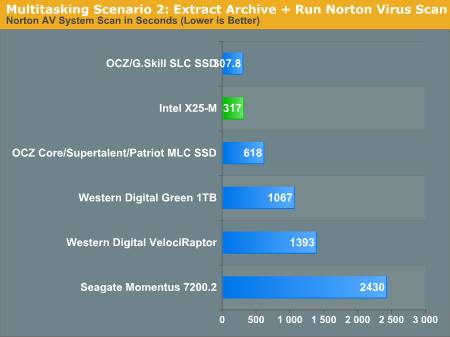Intel X25-M SSD: Intel Delivers One of the World's Fastest Drives
by Anand Lal Shimpi on September 8, 2008 4:00 PM EST- Posted in
- Storage
The Killer App: Multitasking Performance
Here's where things get interesting. I ran two tests, in one I extracted a 5GB archive and tried to run Photoshop after 30 seconds of extraction and in the second test, I extracted a 5GB archive and tried to scan my system for viruses using NAV 2008. Simple enough, right? I'm reporting the times of each task individually.
The extraction task took the longest to complete but the standings speak for themselves:

Here's one area where the Samsung SLC based devices actually come out ahead, by a good margin. The Samsung SLC SSD finished the extraction in 102 seconds, compared to 161 seconds for the X25-M. Even the VelociRaptor did better here at 116 seconds, but remember you need to look at both tasks for a complete picture:

Launching Photoshop took 5.2 seconds for the Samsung SLC SSD, it was like we weren't even running another test in the background. The X25-M did fine at 12.2 seconds and the VelociRaptor was much slower at 27.3 seconds. The JMicron based MLC drives didn't do too bad here either, although they were a little slower than Intel's MLC offering.
The real stress test was this next multitasking scenario. Quite possibly one of the most annoying thing about viruses is having to run real time scanning and protection software all the time, especially with a traditional HDD in your system. The extraction task is the same as before, but the other task is a full system scan in Norton Anti-Virus 2008. I timed both:

The WD 1TB drive would always complete the extraction task quicker than all of the other drives, but paid the penalty in the scan test (which is why you have to look at both charts for a full analysis). The Samsung SLC drive is still the overall winner here, followed closely by Intel's X25-M. The JMicron based MLC drives do horribly here, taking over twice as long to complete as Intel's MLC.
The mechanical disks however do a lot worse. While the Intel X25-M took 3.5 minutes to extract the 5GB archive, the VelociRaptor took over 17 minutes. The Seagate Momentus 7200.2 took over 23 minutes!
Let's look at the NAV results:

The X25-M took around 5.3 minutes, the Raptor needed more than 23 minutes and Seagate Momentus made me wait over 40 minutes. It's these sorts of usage scenarios that really make SSDs worthwhile, and they are the most realworld you can get. When we started looking at real world performance the PCMark Vantage numbers may have looked a bit ridiculous, but by now you should see that they are more of the middle ground when looking at performance of these drives.










96 Comments
View All Comments
aeternitas - Thursday, September 11, 2008 - link
I dont know where you shop, but 100$ can get you 750GB.It doesnt make much of a point anyway, as flash based and typical hard drives will coexist for at least the next ten years. One for preformance, the other for storage.
Maybe some of you are too young to remember, but it was only about 10 years ago that a 20GB hard drive cost 200$ at costco. We are a huge step in terms of the new technology from where we were before. 32 GB for 100$? Yes please. In ten years i expect to see 3+TB flash drives running over 1GBps throughput for around 200$.
strikeback03 - Thursday, September 11, 2008 - link
I assume they were referring to 2.5 inch drives, as those prices are more in line with what was stated.Also don't forget that with the drop in $/GB of drives has come an increase in demand for storage. Ten years ago digital photography was almost non-existent, with file sizes topping out under a megabyte. Images on the web were maybe 640x480. Now we have digital cameras that average 4-6MB as JPEGs, and some can turn out images over 30MB, not counting the medium-format backs (over 100MB IIRC for the 65Megapixel Phase 1). When I was in college any movie you saw on the network was sized to fit a 700MB CD, Now HD movies can range well over that. MP3s are still the same, or you can store in a lossless format if you choose.
Will 3TB be small in 10 years? Possibly. The key for flash completely replacing mechanical will be getting the price low enough to hold large amounts of the current data.
aeternitas - Saturday, September 13, 2008 - link
Even if they were useing 2.5" drives in the example, it doesnt matter. The fact that these drives will be replaceing 3.5" ones makes their point just as misguided in the point they were trying to make.Laptop and desktop drives were differant due to size, now they arnt, so you cant comapair them (HDD vs SSD) in such a illogical manner.
Blimeynext - Friday, April 23, 2010 - link
"Intel went one step further and delivered 5x what the OEMs requested. Thus Intel will guarantee that you can write 100GB of data to one of its MLC SSDs every day, for the next five years, and your data will remain intact."Any tool out there which tells me how much I write to my HDD each day? It would be nice to find out my present usage and compare it with the 100 GB/day limit....
If I write less than 20GB a day does that mean the SSD will last at least 25 years?
Smokerz - Sunday, January 2, 2011 - link
http://www.bit-tech.net/hardware/apple/2010/07/01/...read it all
Smokerz - Sunday, January 2, 2011 - link
sorry for the misspell